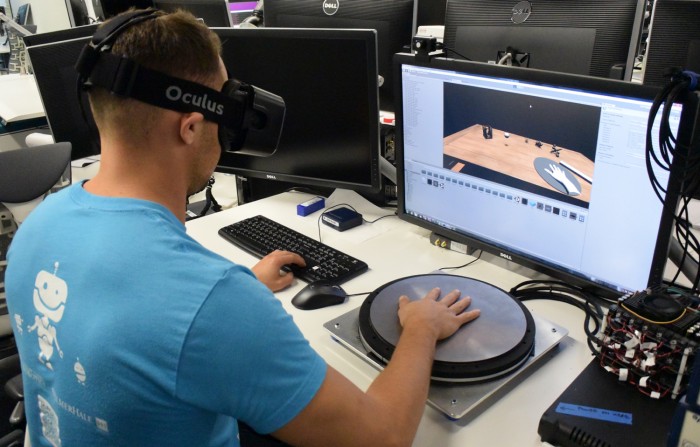Oculus Project Lets You Feel in VR without Gloves
Oculus’s researchers are looking beyond headsets that let you see virtual worlds. In hopes of making virtual reality feel even more immersive, they’re now working on technology that could let you feel virtual objects and tell what direction they’re coming from.
HapticWave, a project from Oculus and Facebook, does this by using a circular metal plate set atop a ring of electromagnet actuators to send vibrations to your bare hand, which is placed in the center of the plate. A headset and audio help the illusion along, says Ravish Mehra, a research scientist at Oculus. Existing haptic technologies tend to give feedback that doesn’t include directional information (think of the buzz of a virtual keyboard on your smartphone as you type), and they’re typically embedded in objects you need to hold or wear, like a glove.
While there’s no way of knowing at this point if HapticWave will make its way into a future Oculus product—Mehra says he can’t comment on that—researchers imagine it being used for things like playing tabletop-style games in virtual reality. You might feel the footsteps of a monster walking by, or sense movements made by a person you’re hanging out with in VR who isn’t physically there.

“Our hope around this project was being able to generate this extrasensory input so users can be more perceptive and more believable of virtual objects,” Mehra says.
The plate, which looks like a turntable, relies on the actuators to produce bending waves sent from specific directions, while accelerometers sense what’s happening on the plate and send feedback that can be used to adjust the actuators. Lower-frequency vibrations are used to give a sense of heavier objects hitting other things in virtual space, while higher frequencies are used to simulate small objects doing so.
In order to get a sense for how immersive HapticWave could be, researchers created a few demos for use with an Oculus Rift VR headset and spatial audio (which tries to re-create where sounds are coming from).
In one, an animated ball bounces across a table. Thanks to vibrations from the plate, a user can see the ball, hear it appear to come closer, and feel where it’s coming from. The user can also use a keyboard to control where the ball moves.
The demos will be presented later this month at the Siggraph computer graphics and interaction conference. Mehra says the researchers next want to investigate making the plate larger and thinner to see how that affects the vibrations. They also want to look deeper at how well people can tell the difference between vibrations of varying resolutions.
Keep Reading
Most Popular
Large language models can do jaw-dropping things. But nobody knows exactly why.
And that's a problem. Figuring it out is one of the biggest scientific puzzles of our time and a crucial step towards controlling more powerful future models.
The problem with plug-in hybrids? Their drivers.
Plug-in hybrids are often sold as a transition to EVs, but new data from Europe shows we’re still underestimating the emissions they produce.
Google DeepMind’s new generative model makes Super Mario–like games from scratch
Genie learns how to control games by watching hours and hours of video. It could help train next-gen robots too.
How scientists traced a mysterious covid case back to six toilets
When wastewater surveillance turns into a hunt for a single infected individual, the ethics get tricky.
Stay connected
Get the latest updates from
MIT Technology Review
Discover special offers, top stories, upcoming events, and more.